Now that we have the STT pairs in Lacerta wrapped up (here and here), we’ll finish this series by looking at four rather challenging STT objects in Cepheus. For the most part, these are going to require apertures of at least six inches in order to have a fighting chance to pry faint companions from obnoxious primarial glares, although OΣ 461 has a little something for everyone, regardless of aperture.
Let’s look at a wide view of where we’re going to spend this observing session and at the same time we’ll get our directions established since they can be confusing this close to Polaris.
Notice Cepheus is parked to the right of Ursa Minor and Polaris in this view. Since Polaris marks celestial north, that means regardless of where you are in Cepheus, north points directly at Polaris — which also means south points in the opposite direction. If you were to look at Cepheus two or three hours after it was in the position shown here, you would notice it was rotating in a direction that takes it up and over Polaris. In the world of celestial directions, the direction the stars move is celestial west, which explains why that “W” is at the top of the directional indicator situated between Cepheus and Polaris. So what that means is the directional indicator has to keep pace with the rotation of the stars . . . and that means it essentially rotates in a counter-clockwise direction to match the rotation of Cepheus.
Also, just to remind us what’s really taking place here, the stars actually aren’t moving at all. We are, and that’s because we have our feet planted firmly on Earth, the rotation of which is the real cause of this long explanation. If you want to delve deeper into celestial directions, see Greg’s post here which goes into the subject in greater detail.
Now let’s put our directional knowledge to good use and go find our first object, OΣ 32 (STT 32), which is north (celestially speaking) of Cepheus. In fact, as the chart below shows, it’s much closer to Polaris than it is to Cepheus, so we’re going to start star hopping from second magnitude Polaris.
Our first stepping stone will be 4.26 magnitude 2 Umi (also known as HIP 5372), which is three degrees southeast of Polaris. From there, it’s just a short hop to the east of 1° 18’ to OΣ 32.
OΣ 32 (STT 32) HIP: 8520 SAO: 282
RA: 01h 49.9m Dec: +85° 13’
Magnitudes: 8.18, 12.5
Separation: 5.3”
Position Angle: 156° (WDS 2000)
Distance: 709 LY (GAIA)
Spectral Class: A is A5
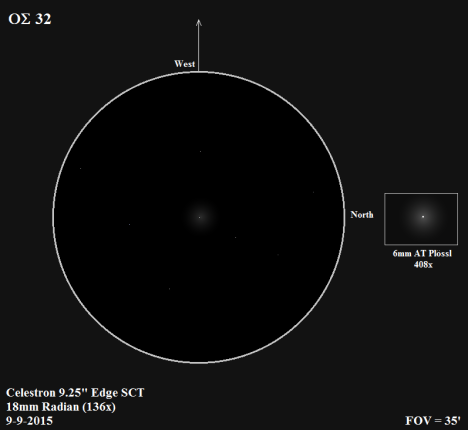
You’ll have to look at the 408x inset at the right to see the elusive secondary of OΣ 32, which is parked at about the seven o’clock position. North and south are reversed in this SCT view, click to enlarge and make it easier to see the secondary.
My first look at the field that contains OΣ 32 was with an 18m Radian (136x) in a 9.25 inch SCT, which doesn’t exactly provide the widest field of view in the universe. Because the secondary couldn’t be seen at that magnification, it was a bit difficult to establish which star was OΣ 32, and it didn’t help that I was looking at a confusing field of stars of similar magnitudes. I finally pinned it down with the help of the three 8.5 to 9th magnitude stars running along a northeast-southwest line across the lower part of the field of view in the sketch and then moving due north from the middle of the three to OΣ 32.
Then began the difficult work of prying the secondary loose from the primary. My first glimpse was a brief averted vision glimpse with a 10mm Radian (240x). The secondary became more distinct at 408x, although it was on the fuzzy side. Because of the interfering 408x primarial glare, it was impossible to compare the magnitude of the secondary with other stars, but given the difficulty it’s possible the secondary is as much as five magnitudes fainter than the primary. The only photometric data I could find on the secondary was a NOMAD1 Vmag of 15.030, which certainly is too faint because that magnitude is well beyond the reach of the 9.25 inch SCT I was using.
It’s interesting to look at the relative motion of the primary and secondary. As the data on the right side of the chart below shows the separation is clearly becoming tighter while at the same time the position angle is edging toward the south, which would indicate the secondary is slowly moving north and west (more west than north) relative to the primary.
And a look at the proper motion data for both stars not only shows that to be the case, but it also shows the primary is moving northeast at the same time – basically in the opposite direction – which has the effect of amplifying the gradual change in position angle and separation. Using the latest GAIA coordinates, dated 2015.0, and comparing them with 2MASS coordinates dated 1999.899, the resulting proper motion data is +013 +014 for the primary (.013” east/yr, .014” north/yr) and -.013” +009” for the secondary (.013” west/yr, .009” north/yr), which confirms the motion necessary to produce the changes in separation and position angle we see.
It’s almost tempting to think of the secondary as being in a very long period orbit around the primary, but the opposing motion of the two stars argues against that. A parallax for the secondary would provide some valuable insight here, but unfortunately that data isn’t available yet from GAIA. So with the information we have now, it appears OΣ 32 is an optical pair. It also appears the two stars are at or near their closest separation now and before long, that separation will begin to increase.
We’ll move back to Cepheus now and start the search for our next star, OΣ 436 (STT 436), from 3.2 magnitude Beta (β) Cephei (here’s our last chart once more). With that star centered in our finder, the first reasonably bright star we see to the northwest is 7.1 magnitude HIP 105490, located 1.5 degrees away. Continuing in the same direction for a distance of 3° 17’, with a very slight northerly tilt, we reach 6.9 magnitude HIP 104458. From there we’ll bend our direction of travel directly to the north a distance of one degree to reach seventh magnitude OΣ 436, which sits halfway between HIP 104458 and 5.9 magnitude HIP 104968.
OΣ 436 (STT 436) HIP: 104667 SAO: 9990
RA: 21h 12.1m Dec: +76° 19’
Magnitudes: 7.09, 11.0
Separation: 11.9”
Position Angle: 227° (WDS 2003)
Distance: 574 LY (Simbad)
Spectral Class: A is B9

You’ll probably have to enlarge this sketch in order to see the faint secondary parked at the eleven o’clock position right next to the primary. There’s a 13th magnitude star a bit farther away at the edge of the primary’s glare, also at the eleven o’clock position, which is not cataloged as part of OΣ 436 . North and south reversed once more to match the SCT view.
Considering the WDS magnitude difference and separation for this pair, I found prying the secondary out of the primarial glare to be a bit more difficult than I expected. Looking around for something to compare with the secondary, my eyes were drawn to UCAC4 832-019368, which appeared to be similar in brightness, and possibly slightly fainter, than the secondary. The UCAC4 catalog lists that star with a Vmag of 11.505, so it’s quite possible the WDS magnitude of 11.0 for the secondary may be a half magnitude too bright, which would account for the unexpected difficulty I had in seeing it. But given the glare from the primary, the difficulty of visually estimating within a half magnitude makes it rather hard to come to a firm conclusion.
Otto Struve discovered this pair in 1848, taking three measures of it, which averaged out to a separation of 11.61” and a position angle of 230.3°. Baron Dembowski measured it in 1868 at 11.66” and 230.0°, followed by W. J. Hussey in 1898 with 11.91” and 229.2° (those numbers come from p. 177 of Hussey’s book on Otto Struve’s double stars). So when compared with the 2003 data of 11.9” and 227°, which is the most recent listed in the WDS catalog, this pair is remarkably stable.
Now we’ll head into the southeastern corner of Cepheus, which is more densely populated with stars thanks to it’s location at the edge of the Milky Way.
We’ll start with 3.5 magnitude Zeta (ζ) Cephei, hop northward 1 degree to 5.05 magnitude Lambda (λ) Cephei, and then make a right angle turn to the west and hop another full degree to reach OΣ 461 (STT 461).
OΣ 461 (STT 461) (15 Cep) HIP: 108925 SAO: 34016
RA: 22h 03.9m Dec: +59° 49’
Identifier Magnitudes Separation PA WDS Data
| AB: | 6.66 | 11.40 | 11.00” | 297° | 2011 |
| AC: | 6.66 | 10.03 | 89.90” | 40° | 2011 |
| AD: | 6.66 | 7.84 | 184.30” | 72° | 2011 |
| AE: | 6.66 | 6.96 | 237.40” | 37° | 2011 |
| AG: | 6.66 | 14.30 | 17.50” | 335° | 2007 |
| EF | 6.96 | 8.14 | 192.60” | 33° | 2011 |
Distance: 1469 LY (Simbad)
Spectral Classes: A is B1, D is A, E is A0
I’ve written about OΣ 461 before (here), so I’ll mainly concentrate on the B and G components here, which were the main focus for this project.

The B component is rather obvious at the one o’clock position in this sketch, but you’ll have to look closer to pick out the much fainter G component, both of which are labeled in the box on the right side of the sketch. There’s plenty of competition for your eye in this view with lots of scattered light radiating from the D and E companions. North and south reversed again to match the SCT view, click to enlarge.
I had no problem picking B out of the 6.66 magnitude glare of the primary – it was easy with averted vision at 204x and 240x, and it popped into direct vision view at 408x. I noticed UCAC4 749-071975, shown below and to the left of the primary in the sketch, was similar in brightness to B. The UCAC4 catalog lists a Vmag of 12.114 for the comparison star, an f.mag of 11.784, and its J and K magnitudes compute to a visual magnitude of 11.906. All of those values tend to suggest the B component is slightly fainter than the 11.40 value assigned to it in the WDS.
Based on the 14.3 magnitude assigned to it in the WDS, I really didn’t expect to see the G component, so I wasn’t surprised to find it was invisible when I first looked for it at 240x. After I increased the magnification to 408x, my prying eyes latched on to it with averted vision, and when I went back to 240x, I was able to catch it again with averted vision. If it was really a 14.3 magnitude star, G would have been beyond the reach of the 9.25” SCT, especially given the glare of the primary. The UCAC4 catalog lists an f.mag of 13.321 for it, and URAT1 lists a more optimistic f.mag of 12.97. Neither catalog shows a Vmag for the star, but both have the same J and K magnitude values for it, which works out to a visual magnitude of 13.237. Even that would have been tough to see in the glare of the primary, so I suspect the actual visual magnitude is in the 13.0 range.
Regardless of whether you succeed in picking out the G component with whatever scope you’re using, it’s worth ratcheting up the magnification to the 400x range just to enjoy the magnified spectacle of white light pouring out of the primary and its D and E companions. Don’t pass up that chance — OΣ 461 is really a spectacular grouping of stars.
Our last Otto Struve discovery on this tour is OΣ 458 (STT 458), which is a short one degree hop due west from OΣ 461 (here’s our last chart again). You can use 7.85 magnitude SAO 33939 as a reference point to keep you on course.
OΣ 458 (STT 458) HIP: 108301 SAO: 33894
RA: 21h 56.5m Dec: +59° 48’
Magnitudes AB: 7.20, 8.41 AC: 7.20, 12.60
Separations AB: 1.00” AC: 21.60”
Position Angle AB: 348° (WDS 2014) AC: 24° (WDS 2003)
Distance: 1469 LY (Simbad)
Spectral Class: A is A0
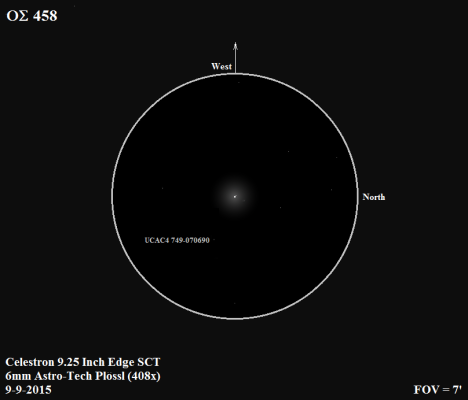
The goal here was the C companion, which wasn’t all that difficult given it’s distance and cooperative magnitude. But splitting the tight AB pair was a real bonus and not as difficult as I expected it to be. North and south reversed once again, click to improve the view.
UCAC4 749-070690 caught my eye when I was looking for a comparison star for the C component of OΣ 458. The UCAC4 labeled star has a Vmag of 12.119, an f.mag of 12.011, and its J and K magnitudes work out to a visual magnitude of 11.620. The C component looked a bit fainter than the UCAC4 star, so it appears likely the WDS magnitude of 12.60 for it is about right.
What is now labeled as the AB pair of OΣ 458 was first measured in 1845 by Johann Heinrich Mädler with an erroneous position angle of 44.6 degrees, which also included a remark by Mädler that he was uncertain if the star he measured was elongated. The WDS shows the first recorded measure of the pair was in 1846 (350° and .7”). Hussey shows Otto Struve measuring the pair in 1851, but as you can see in the excerpt at the right from Hussey’s book, the 1851 measures appear to be in error in comparison to the measures made in 1870, 1878, 1889, and 1898. Also shown in the excerpt from Hussey’s book is S.W. Burnham’s initial 1878 measure of what is now the C component at 32.9° and 22.71”.
Looking at the apparent widening separation of the AB pair, it appears there’s some relative motion of the two stars taking place. URAT1 shows the primary with proper motion of +053 +017 (.053”/yr east, .017”/yr north), but neither it or GAIA shows any proper motion data for B, nor do they include coordinates for it. There’s also relative motion taking place with respect to the A and C components, and judging by the PM data listed in URAT1 for C, +005 +011 (.005”/yr east, .011”/yr north), the primary is outrunning the C companion in a northeasterly direction – not by a lot, but enough to result in a gradual widening of the separation.
Speaking of outrunning, we’re running out of space (and time), so it’s time to wrap up this three part look at STT pairs in Lacerta and Cepheus and move on to less difficult targets which are in the range of smaller scopes. Next trip we’ll wander over to a neglected area of Andromeda and round up a wide variety of double and multiple stars, so stay tuned.
Meanwhile, clear skies and cooperative seeing! 😎
Filed under: 4. Choose a Constellation:, Cepheus |


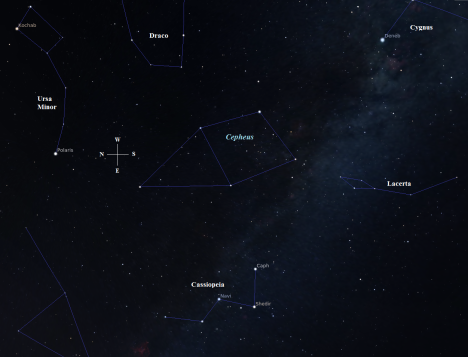
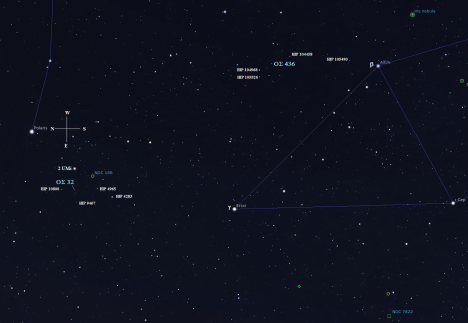
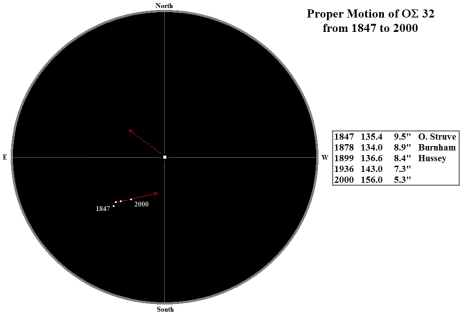
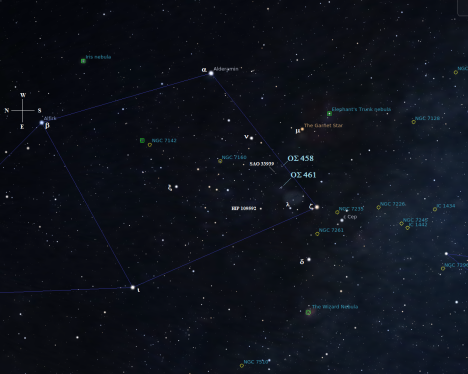
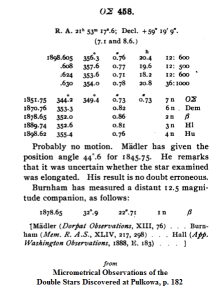
Hi John! You must have had some pretty good conditions to ratchet up the magnification to 408x! I had to bring down an ailing Elm tree behind the garage….the plus side is that this part of the sky is now available for home observing once again.
Great report!!
Cheers, Chris.
Hi Chris,
My motto with magnification is: If you never try, you’ll never know. I’ve been surprised more than once by what I could see at high magnification during poor seeing conditions. Logic would argue that shouldn’t happen, but it appears logic isn’t always logical . . . and there’s nothing logical about that.
John